Abstract
OBJECTIVE: The use of hypertonic sodium solutions (HSS) and lactated Ringer's (LR) solution in the resuscitation of patients with major burns was compared. SUMMARY BACKGROUND DATA: Hypertonic sodium solutions have been recommended for burn resuscitation to reduce the large total volumes required with isotonic LR solution and their attendant complications. METHODS: To evaluate the efficacy of this therapy in our adult burn center, we resuscitated 65 consecutive patients with HSS (290 mEq/L Na) between July 1991 and June 1993 and compared them with 109 burn patients resuscitated with LR (130 mEq/L Na) between July 1986 and June 1988 (LR-1). A subsequent 39 patients were resuscitated with LR between September 1993 and August 1994 (LR-2). RESULTS: Patients receiving hypertonic sodium solutions versus LR-1 were similar with respect to age (46.0 vs. 43.6 years), total burn size (39.2% vs. 39.9%), incidence of inhalation injury (41.5% vs. 47.7%), and predicted mortality (34.6% vs. 30.2%). Total resuscitation volumes during the first 24 hours were lower among patients treated with HSS than those in the LR-1 group (3.9 +/- 0.3 vs. 5.3 +/- 0.2 mL/kg/% body surface area [BSA], p < 0.05). After 48 hours, however, cumulative fluid loads were similar (6.6 +/- 0.6 vs. 7.5 +/- 0.3 mL/kg/%BSA), and total sodium load was greater with the HSS group (1.3 +/- 0.1 vs. 0.9 +/- 0.1 mEq/kg/%BSA, p < 0.002). During the first 3 days after burn, serum sodium concentrations were moderately elevated in the HSS patients (153 +/- 2 vs. 135 +/- 1 mEq/L, p < 0.001). Patients resuscitated with HSS had a fourfold increase in renal failure (40.0 vs. 10.1%, p < 0.001) and twice the mortality of LR-1 patients (53.8 vs. 26.6%, p < 0.001). In patients resuscitated with HSS, renal failure was an independent risk factor (p < 0.001, by logistic regression). Analysis of these results prompted a return to LR resuscitation (LR-2). Age (41.6 +/- 2.9 years), burn size (37.8 +/- 3.9 %BSA), and incidence of inhalation injury (51.3%) were similar to the earlier groups. Total sodium load was less among LR-2 patients than the HSS group (0.7 +/- 0.1 mEq/kg/%BSA, p < 0.01), but similar to the LR-1 patients. Renal failure developed in only 15.4%, and 33.3% died, similar to the LR-1 group and significantly lower than patients treated with HSS (p < 0.001 and p < 0.05, respectively). CONCLUSION: Hypertonic sodium solution resuscitation of burn patients did not reduce the total resuscitation volume required. Furthermore, it was associated with an increased incidence of renal failure and death. The use of HSS for burn resuscitation may be ill advised.
Full text
PDF

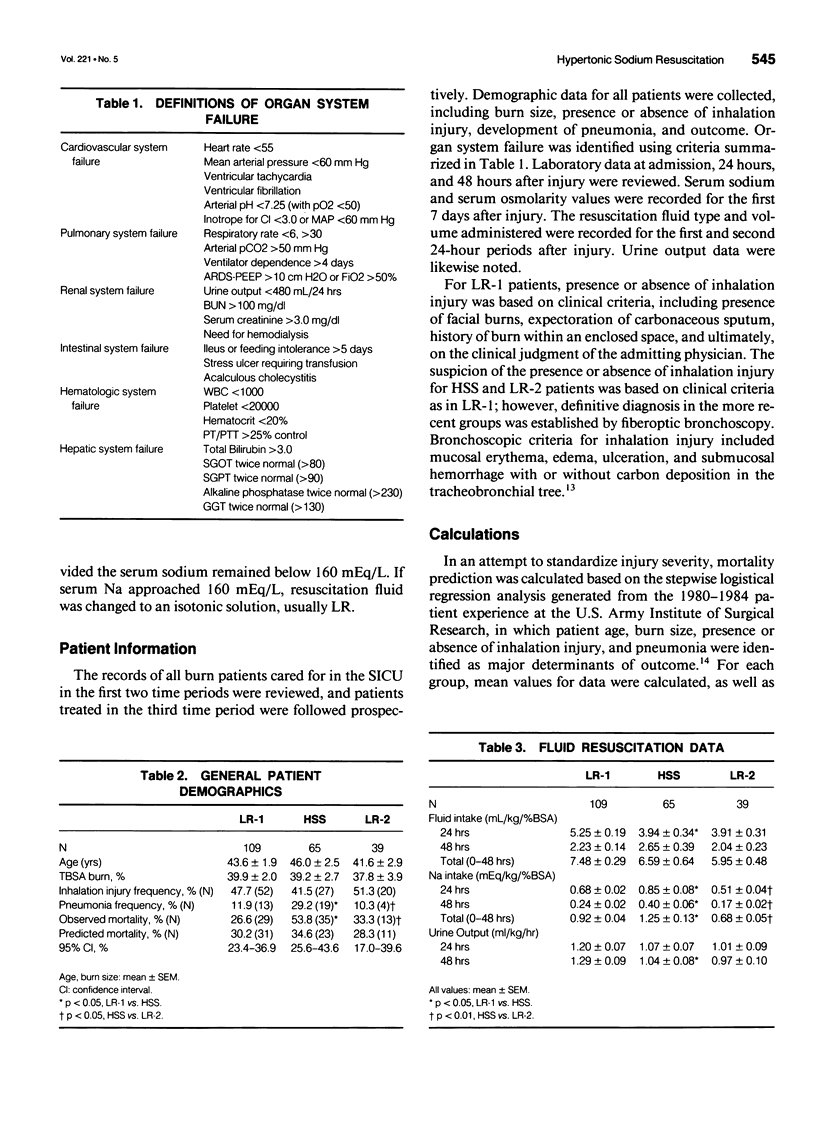
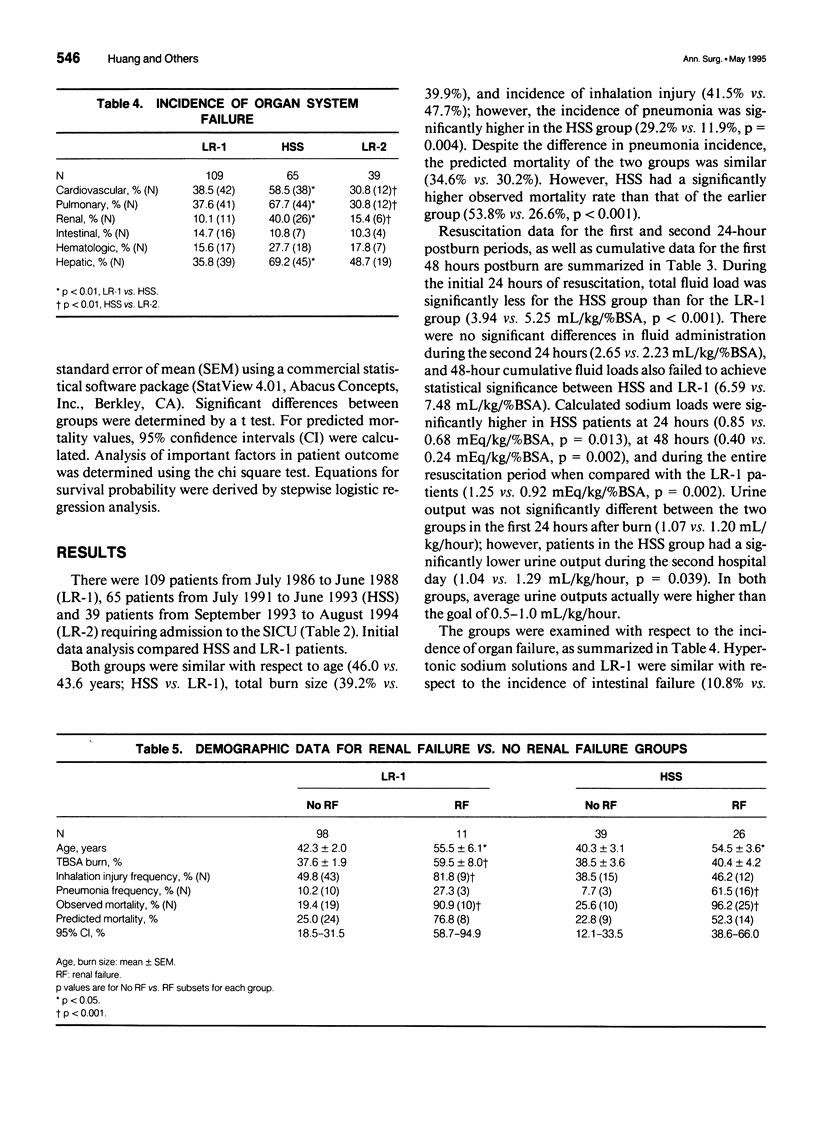

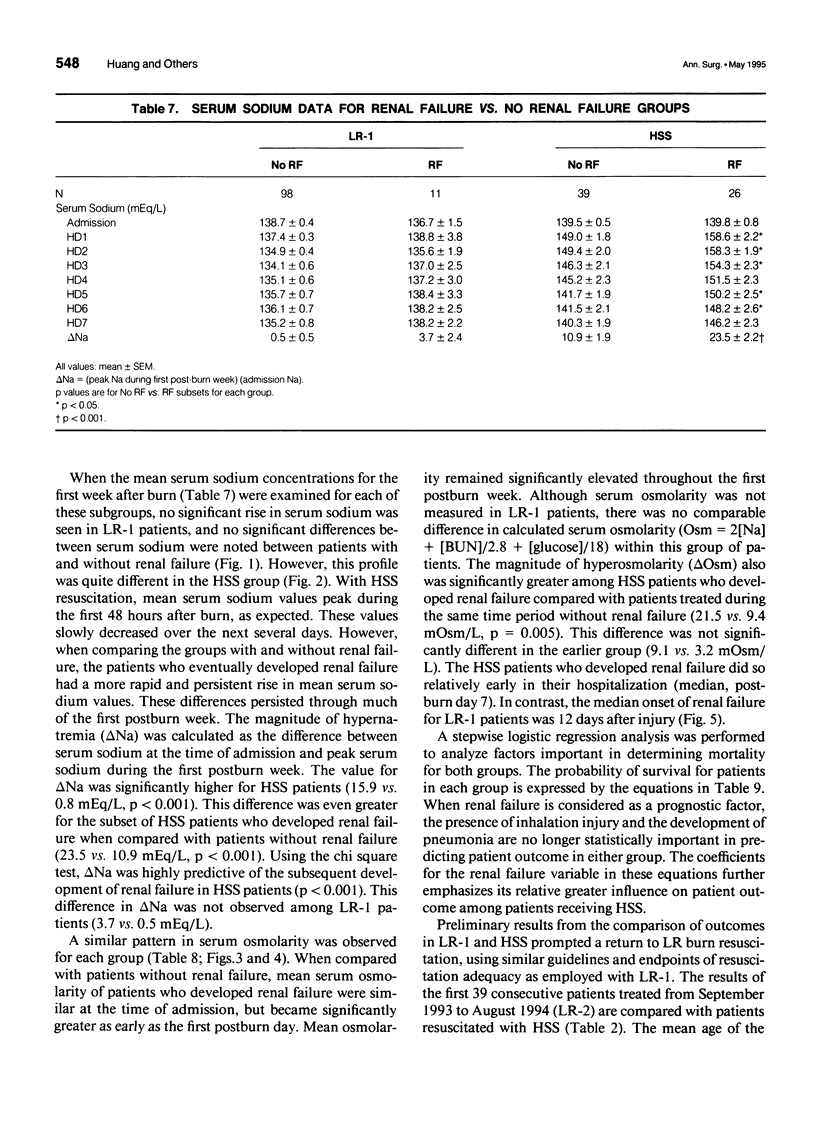
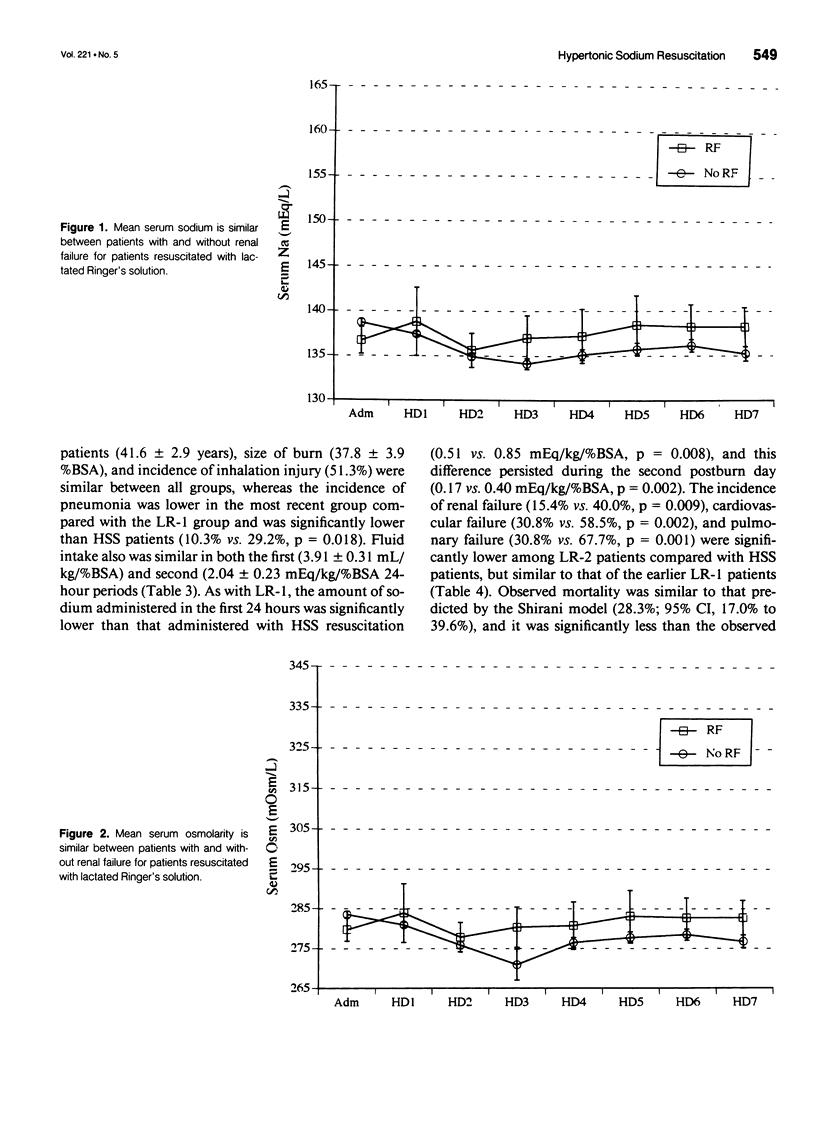
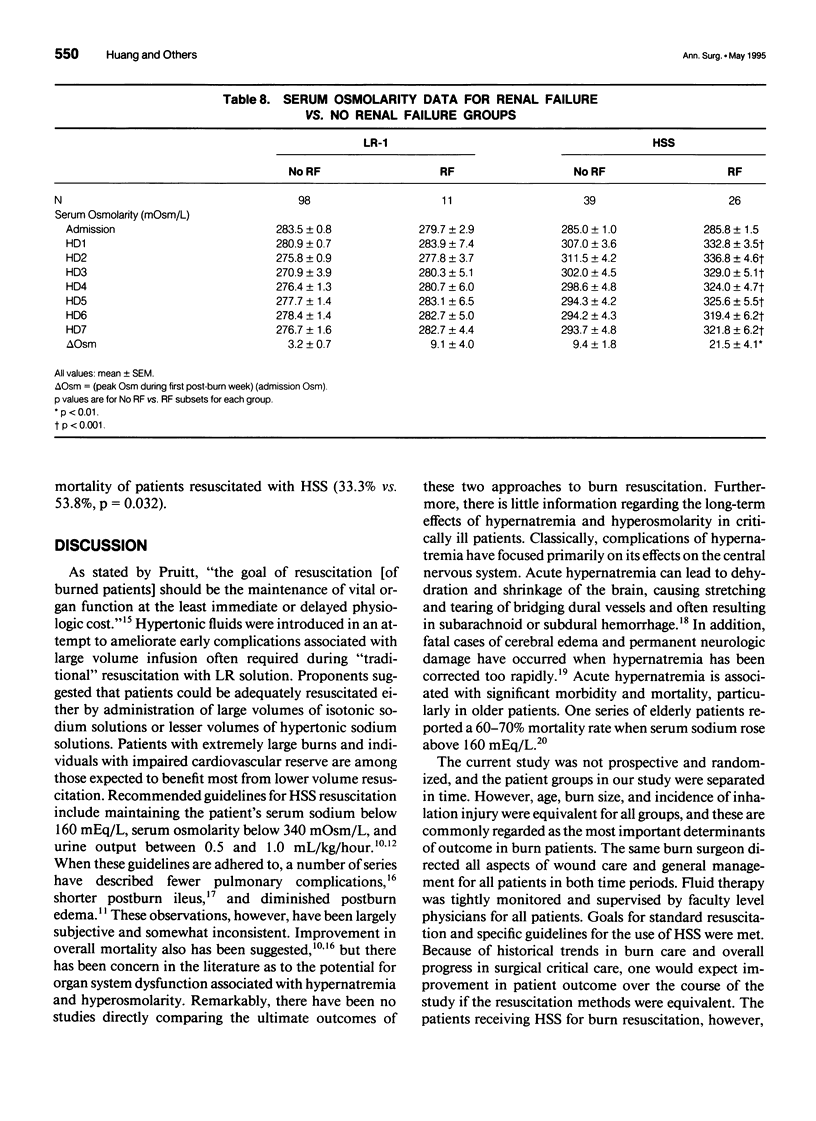
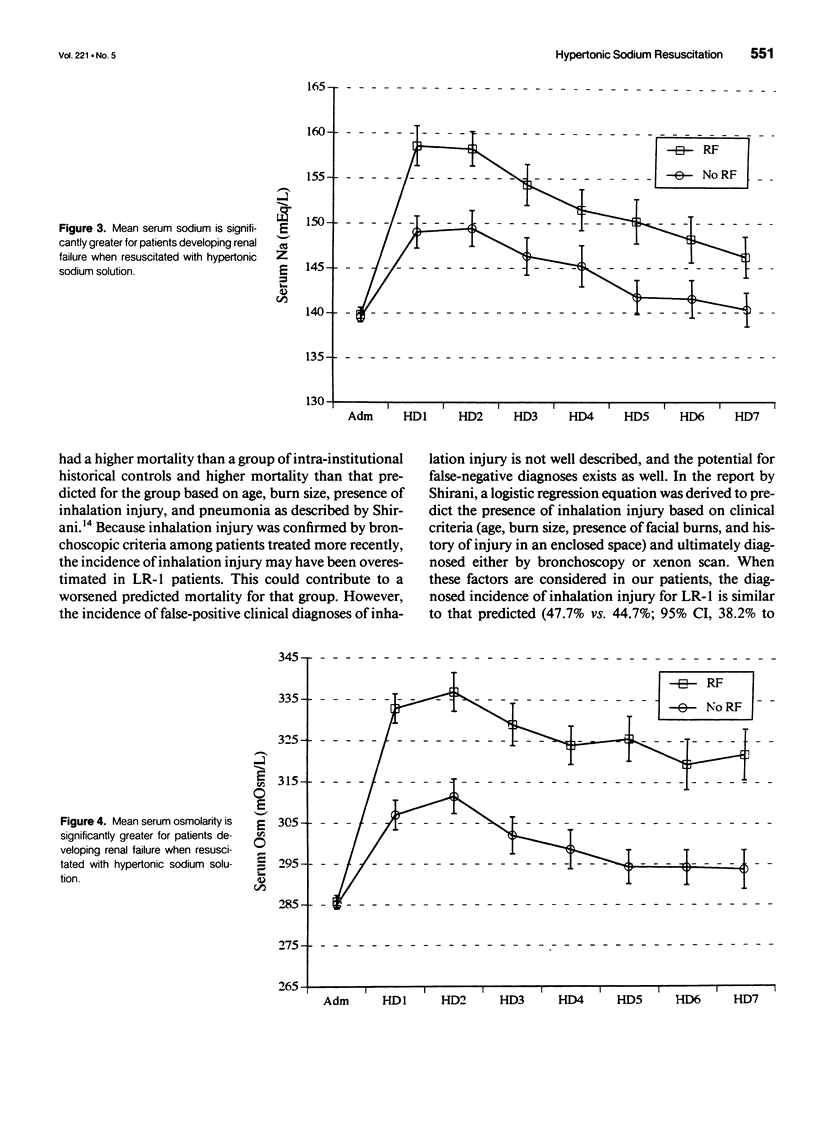
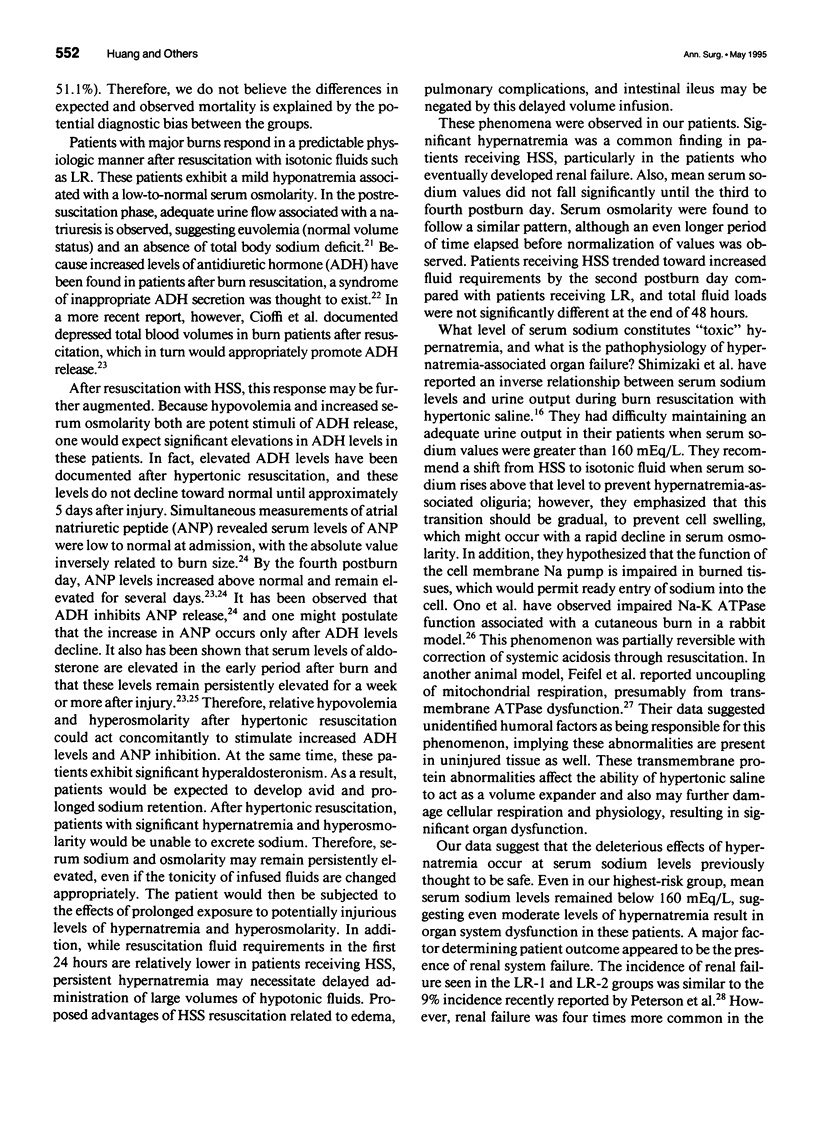
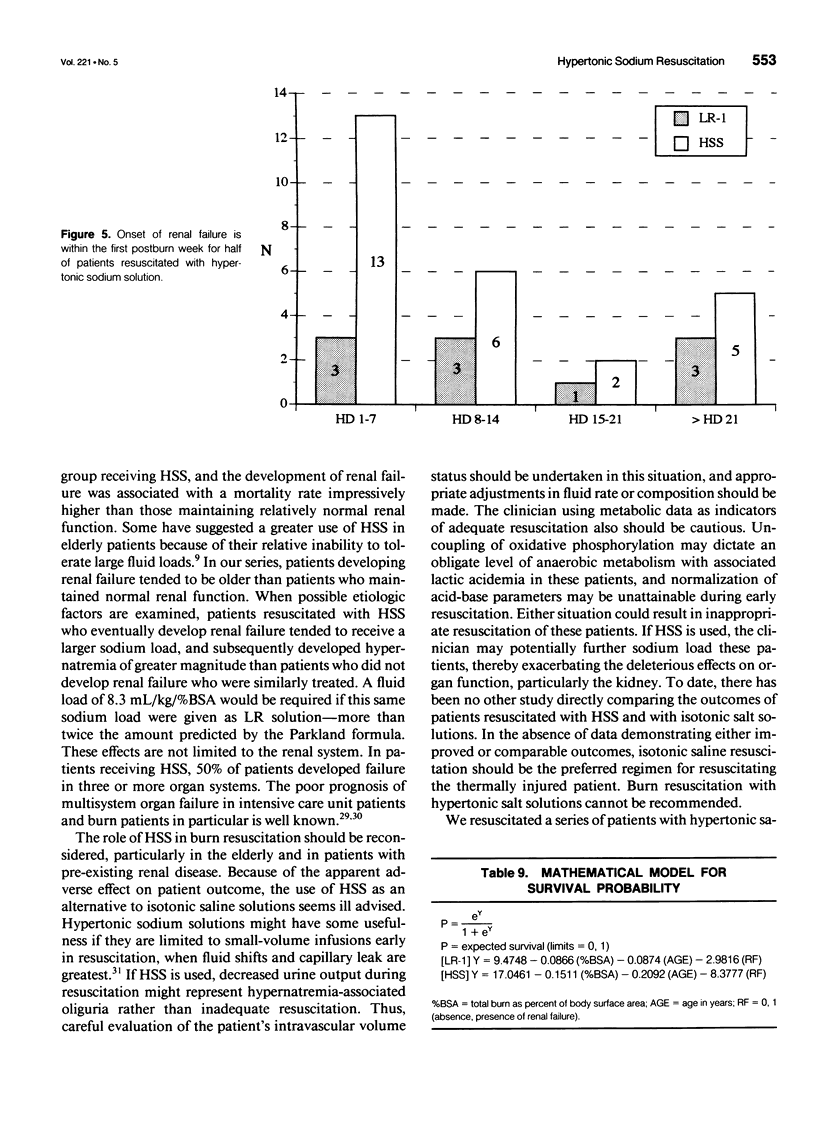
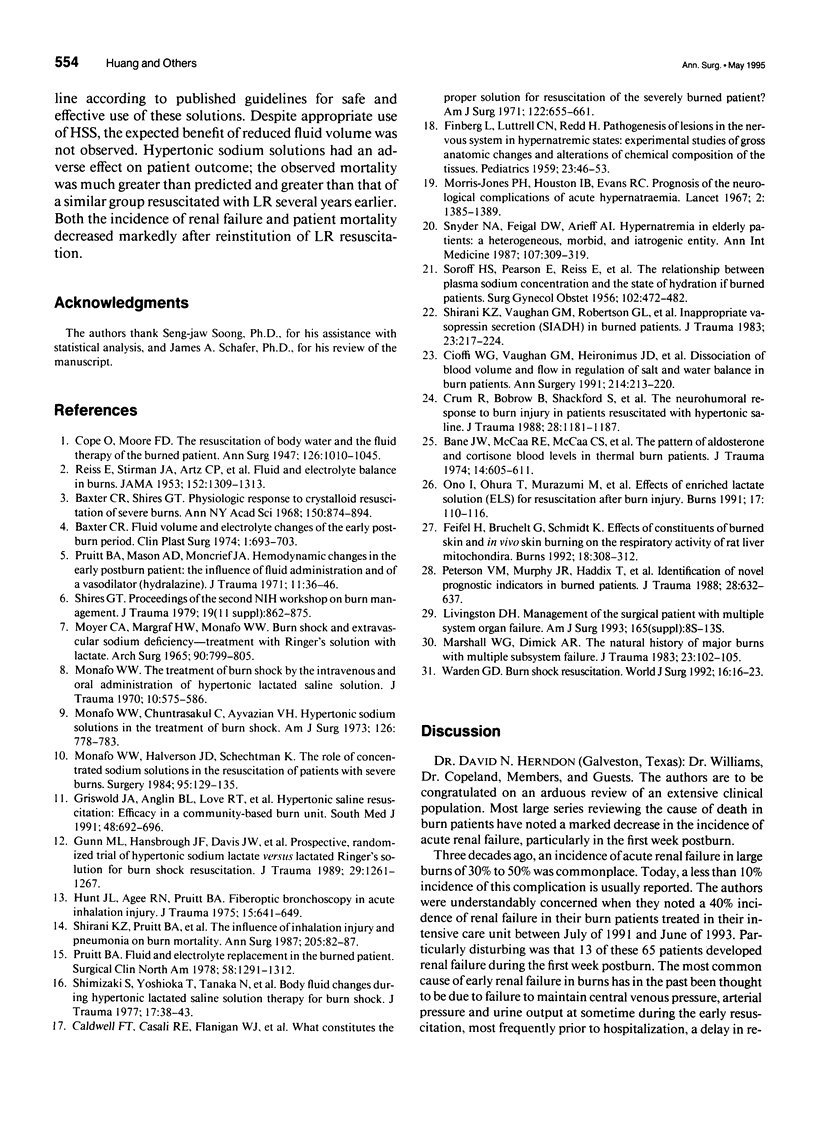
Selected References
These references are in PubMed. This may not be the complete list of references from this article.
- Bane J. W., McCaa R. E., McCaa C. S., Read V. H., Turney W. H., Turner M. D. The pattern of aldosterone and cortisone blood levels in thermal burn patients. J Trauma. 1974 Jul;14(7):605–611. doi: 10.1097/00005373-197407000-00008. [DOI] [PubMed] [Google Scholar]
- Baxter C. R. Fluid volume and electrolyte changes of the early postburn period. Clin Plast Surg. 1974 Oct;1(4):693–703. [PubMed] [Google Scholar]
- Baxter C. R., Shires T. Physiological response to crystalloid resuscitation of severe burns. Ann N Y Acad Sci. 1968 Aug 14;150(3):874–894. doi: 10.1111/j.1749-6632.1968.tb14738.x. [DOI] [PubMed] [Google Scholar]
- Cioffi W. G., Jr, Vaughan G. M., Heironimus J. D., Jordan B. S., Mason A. D., Jr, Pruitt B. A., Jr Dissociation of blood volume and flow in regulation of salt and water balance in burn patients. Ann Surg. 1991 Sep;214(3):213–220. doi: 10.1097/00000658-199109000-00004. [DOI] [PMC free article] [PubMed] [Google Scholar]
- Cope O., Moore F. D. The Redistribution of Body Water and the Fluid Therapy of the Burned Patient. Ann Surg. 1947 Dec;126(6):1010–1045. doi: 10.1097/00000658-194712000-00013. [DOI] [PMC free article] [PubMed] [Google Scholar]
- Crum R., Bobrow B., Shackford S., Hansbrough J., Brown M. R. The neurohumoral response to burn injury in patients resuscitated with hypertonic saline. J Trauma. 1988 Aug;28(8):1181–1187. doi: 10.1097/00005373-198808000-00008. [DOI] [PubMed] [Google Scholar]
- FINBERG L., LUTTRELL C., REDD H. Pathogenesis of lesions in the nervous system in hypernatremic states. II. Experimental studies of gross anatomic changes and alterations of chemical composition of the tissues. Pediatrics. 1959 Jan;23(1 Pt 1):46–53. [PubMed] [Google Scholar]
- Feifel H., Bruchelt G., Schmidt K. Effect of constituents of burned skin and in vivo skin burning on the respiratory activity of rat liver mitochondria. Burns. 1992 Aug;18(4):308–312. doi: 10.1016/0305-4179(92)90152-k. [DOI] [PubMed] [Google Scholar]
- Griswold J. A., Anglin B. L., Love R. T., Jr, Scott-Conner C. Hypertonic saline resuscitation: efficacy in a community-based burn unit. South Med J. 1991 Jun;84(6):692–696. [PubMed] [Google Scholar]
- Gunn M. L., Hansbrough J. F., Davis J. W., Furst S. R., Field T. O. Prospective, randomized trial of hypertonic sodium lactate versus lactated Ringer's solution for burn shock resuscitation. J Trauma. 1989 Sep;29(9):1261–1267. doi: 10.1097/00005373-198909000-00013. [DOI] [PubMed] [Google Scholar]
- Hunt J. L., Agee R. N., Pruitt B. A., Jr Fiberoptic bronchoscopy in acute inhalation injury. J Trauma. 1975 Aug;15(8):641–649. doi: 10.1097/00005373-197508000-00004. [DOI] [PubMed] [Google Scholar]
- Livingston D. H. Management of the surgical patient with multiple system organ failure. Am J Surg. 1993 Feb;165(2A):8S–13S. doi: 10.1016/s0002-9610(05)81201-2. [DOI] [PubMed] [Google Scholar]
- MOYER C. A., MARGRAF H. W., MONAFO W. W., Jr BURN SHOCK AND EXTRAVASCULAR SODIUM DEFICIENCY--TREATMENT WITH RINGER'S SOLUTION WITH LACTATE. Arch Surg. 1965 Jun;90:799–811. doi: 10.1001/archsurg.1965.01320120001001. [DOI] [PubMed] [Google Scholar]
- Marshall W. G., Jr, Dimick A. R. The natural history of major burns with multiple subsystem failure. J Trauma. 1983 Feb;23(2):102–105. doi: 10.1097/00005373-198302000-00005. [DOI] [PubMed] [Google Scholar]
- Monafo W. W., Chuntrasakul C., Ayvazian V. H. Hypertonic sodium solutions in the treatment of burn shock. Am J Surg. 1973 Dec;126(6):778–783. doi: 10.1016/s0002-9610(73)80070-4. [DOI] [PubMed] [Google Scholar]
- Monafo W. W., Halverson J. D., Schechtman K. The role of concentrated sodium solutions in the resuscitation of patients with severe burns. Surgery. 1984 Feb;95(2):129–135. [PubMed] [Google Scholar]
- Monafo W. W. The treatment of burn shock by the intravenous and oral administration of hypertonic lactated saline solution. J Trauma. 1970 Jul;10(7):575–586. doi: 10.1097/00005373-197007000-00006. [DOI] [PubMed] [Google Scholar]
- Morris-Jones P. H., Houston I. B., Evans R. C. Prognosis of the neurological complications of acute hypernatraemia. Lancet. 1967 Dec 30;2(7531):1385–1389. doi: 10.1016/s0140-6736(67)93022-x. [DOI] [PubMed] [Google Scholar]
- Ono I., Ohura T., Sakamura R., Murazumi M., Sekido M., Miyashita M., Goto M., Kato S., Sumiya S. Effects of enriched lactate solution (ELS) for resuscitation after burn injury. Burns. 1991 Apr;17(2):110–116. doi: 10.1016/0305-4179(91)90133-2. [DOI] [PubMed] [Google Scholar]
- Peterson V. M., Murphy J. R., Haddix T., Ford P., Anderson S. J., Bartle E. J. Identification of novel prognostic indicators in burned patients. J Trauma. 1988 May;28(5):632–637. doi: 10.1097/00005373-198805000-00012. [DOI] [PubMed] [Google Scholar]
- Pruitt B. A., Jr Fluid and electrolyte replacement in the burned patient. Surg Clin North Am. 1978 Dec;58(6):1291–1312. doi: 10.1016/s0039-6109(16)41692-0. [DOI] [PubMed] [Google Scholar]
- Pruitt B. A., Jr, Mason A. D., Jr, Moncrief J. A. Hemodynamic changes in the early postburn patient: the influence of fluid administration and of a vasodilator (hydralazine). J Trauma. 1971 Jan;11(1):36–46. doi: 10.1097/00005373-197101000-00003. [DOI] [PubMed] [Google Scholar]
- REISS E., STIRMANN J. A., ARTZ C. P., DAVIS J. H., AMSPACHER W. H. Fluid and electrolyte balance in burns. J Am Med Assoc. 1953 Aug 1;152(14):1309–1313. doi: 10.1001/jama.1953.03690140017004. [DOI] [PubMed] [Google Scholar]
- SOROFF H. S., PEARSON E., REISS E., ARTZ C. P. The relationship between plasma sodium concentration and the state of hydration of burned patients. Surg Gynecol Obstet. 1956 Apr;102(4):472–482. [PubMed] [Google Scholar]
- Shimazaki S., Yoshioka T., Tanaka N., Sugimoto T., Onji Y. Body fluid changes during hypertonic lactated saline solution therapy for burn shock. J Trauma. 1977 Jan;17(1):38–43. doi: 10.1097/00005373-197701000-00005. [DOI] [PubMed] [Google Scholar]
- Shirani K. Z., Pruitt B. A., Jr, Mason A. D., Jr The influence of inhalation injury and pneumonia on burn mortality. Ann Surg. 1987 Jan;205(1):82–87. doi: 10.1097/00000658-198701000-00015. [DOI] [PMC free article] [PubMed] [Google Scholar]
- Shirani K. Z., Vaughan G. M., Robertson G. L., Pruitt B. A., Jr, McManus W. F., Stallings R. J., Mason A. D., Jr Inappropriate vasopressin secretion (SIADH) in burned patients. J Trauma. 1983 Mar;23(3):217–224. doi: 10.1097/00005373-198303000-00007. [DOI] [PubMed] [Google Scholar]
- Snyder N. A., Feigal D. W., Arieff A. I. Hypernatremia in elderly patients. A heterogeneous, morbid, and iatrogenic entity. Ann Intern Med. 1987 Sep;107(3):309–319. doi: 10.7326/0003-4819-107-2-309. [DOI] [PubMed] [Google Scholar]
- Warden G. D. Burn shock resuscitation. World J Surg. 1992 Jan-Feb;16(1):16–23. doi: 10.1007/BF02067109. [DOI] [PubMed] [Google Scholar]


